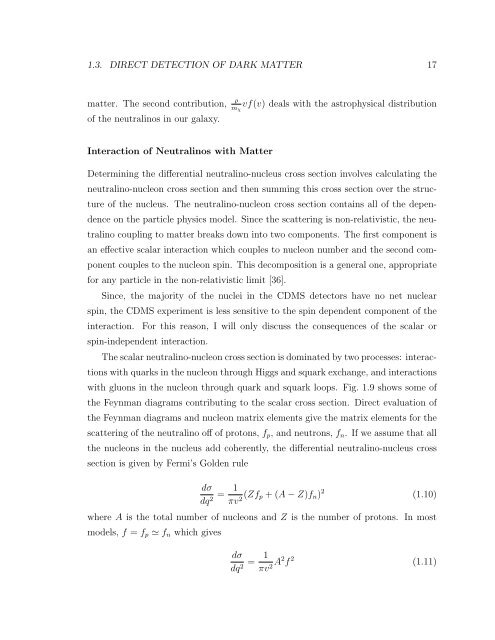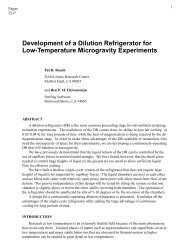cdms-ii - CDMS Experiment - University of California, Berkeley
cdms-ii - CDMS Experiment - University of California, Berkeley
cdms-ii - CDMS Experiment - University of California, Berkeley
You also want an ePaper? Increase the reach of your titles
YUMPU automatically turns print PDFs into web optimized ePapers that Google loves.
1.3. DIRECT DETECTION OF DARK MATTER 17<br />
matter. The second contribution,<br />
<strong>of</strong> the neutralinos in our galaxy.<br />
ρ<br />
m χ<br />
vf(v) deals with the astrophysical distribution<br />
Interaction <strong>of</strong> Neutralinos with Matter<br />
Determining the differential neutralino-nucleus cross section involves calculating the<br />
neutralino-nucleon cross section and then summing this cross section over the structure<br />
<strong>of</strong> the nucleus. The neutralino-nucleon cross section contains all <strong>of</strong> the dependence<br />
on the particle physics model. Since the scattering is non-relativistic, the neutralino<br />
coupling to matter breaks down into two components. The first component is<br />
an effective scalar interaction which couples to nucleon number and the second component<br />
couples to the nucleon spin. This decomposition is a general one, appropriate<br />
for any particle in the non-relativistic limit [36].<br />
Since, the majority <strong>of</strong> the nuclei in the <strong>CDMS</strong> detectors have no net nuclear<br />
spin, the <strong>CDMS</strong> experiment is less sensitive to the spin dependent component <strong>of</strong> the<br />
interaction.<br />
For this reason, I will only discuss the consequences <strong>of</strong> the scalar or<br />
spin-independent interaction.<br />
The scalar neutralino-nucleon cross section is dominated by two processes: interactions<br />
with quarks in the nucleon through Higgs and squark exchange, and interactions<br />
with gluons in the nucleon through quark and squark loops. Fig. 1.9 shows some <strong>of</strong><br />
the Feynman diagrams contributing to the scalar cross section. Direct evaluation <strong>of</strong><br />
the Feynman diagrams and nucleon matrix elements give the matrix elements for the<br />
scattering <strong>of</strong> the neutralino <strong>of</strong>f <strong>of</strong> protons, f p , and neutrons, f n . If we assume that all<br />
the nucleons in the nucleus add coherently, the differential neutralino-nucleus cross<br />
section is given by Fermi’s Golden rule<br />
dσ<br />
dq 2 = 1<br />
πv 2 (Zf p + (A − Z)f n ) 2 (1.10)<br />
where A is the total number <strong>of</strong> nucleons and Z is the number <strong>of</strong> protons. In most<br />
models, f = f p ≃ f n which gives<br />
dσ<br />
dq 2 = 1<br />
πv 2 A2 f 2 (1.11)




